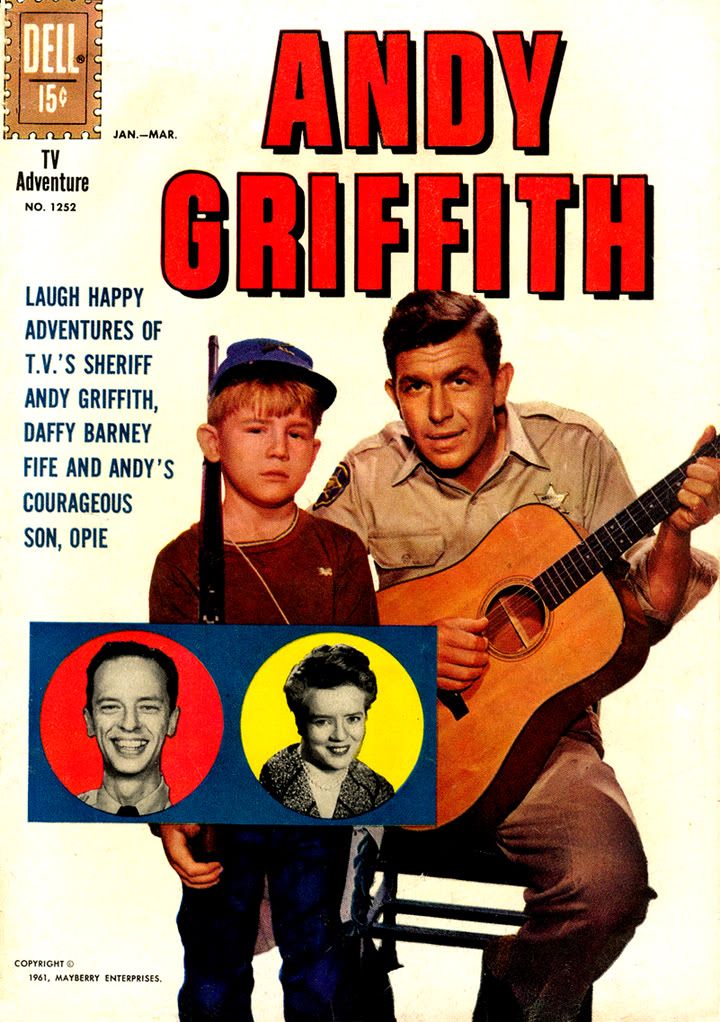 |
| Aunt Bee: not in this issue! |
So it wasn't much of a coincidence I'd been planning to write a little bit about the Dell Andy Griffith Show comics when I heard about Griffith's death. I think about my dad every day and if I reminisce about him long enough, it invariably leads me to thinking about Andy Griffith. I just wrote about No Time for Sergeants, a hilarious flick that hasn't gotten its due over the years. It helped bring about Mayberry, all its citizens and spin-off Gomer Pyle, U.S.M.C., for which we'll forgive it. We're generous that way.
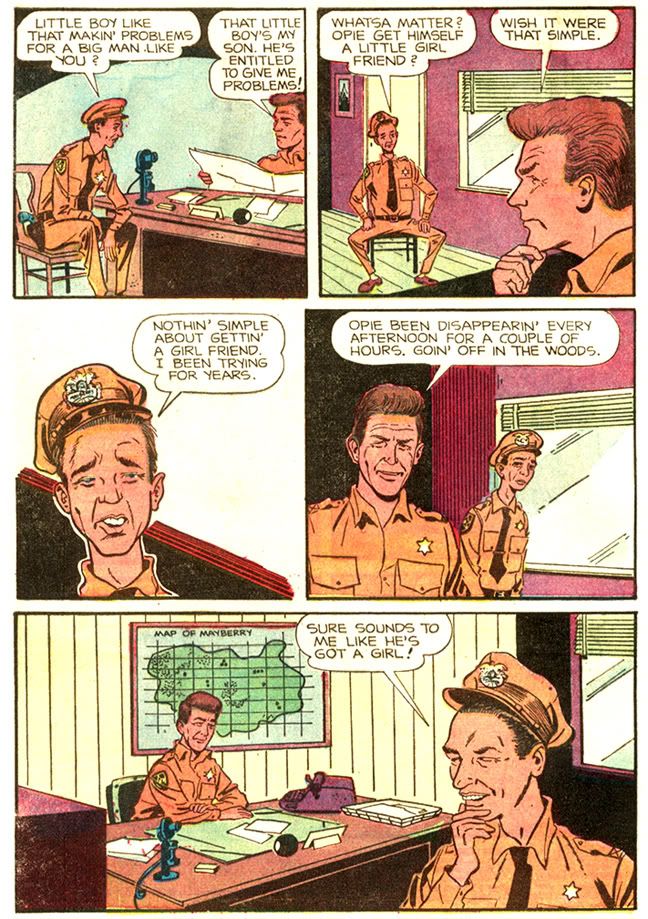 |
| They sure move around a lot. |
I'm not sure what makes Opie so courageous. The story inside is called "Opie's Secret," which turns out to be pretty lame as far as secrets go. Andy worries that the boy's spending too much time in the woods outside town, but instead of wandering off with a crinkled paper sack of porn for furtive masturbation sessions like Joaquin "Leaf" Phoenix in Ron Howard's own Parenthood, Opie's just caring for a litter of puppies. Plus, we know the Mayberry woods are about as dangerous as a daycare center, and not one of those ones with the careless teachers who leave matches lying around and rusty knives. The good daycare centers.
None of Opie's wholesome activities require much in the way of bravery, or, if you will, courageousness. I tend to reserve the label "courageous" for kids who sail solo around the world, do something wonderful for the disadvantaged in the face of community disapproval, rescue their families from burning houses, inspire others with their perseverance against some fatal disease or take a stance against bullies. But perhaps the people at Dell were mild-mannered to the extreme and in their eyes Opie was some kind of free-spirited adventurer, living life on the razor's edge of danger.
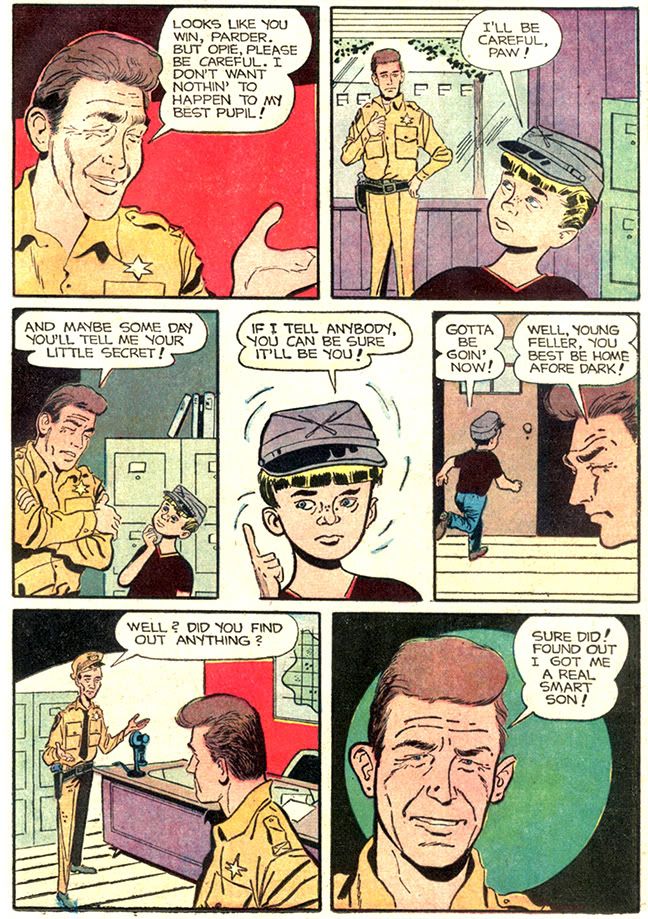 |
| Ron Howard wore this cap in "Eat My Dust." |
On the other hand, the writer captures quite a bit of the show's flavor, especially in the way Andy relates to Opie and Barney.
Ron Howard's Opie was one of the more "real" kid characters on TV, neither a smart-aleck nor a naif. And unlike poor Theodore Cleaver, who seems to have been a bit slow at times (putting it politely), Opie was more than capable of handling his own problems with just a smidgen of guidance and advice from his pa. And avoiding embarrassing scenes like getting his head stuck in iron fences or falling into giant bowls of fake soup.
In episodes like "Opie the Birdman," (which aired a year or so after these comics hit the newsstands) the show's writers give father and son a mutual respect and even allow for a little anger between them. Opie would learn from Andy, but occasionally Andy would also learn from Opie. The heart-to-heart talk scene between Andy and Opie in "Opie's Secret" captures this dynamic quite well and so gains its own mild emotional resonance. I can't imagine Pa Kent talking to Clark as honestly as this in a Superboy story. Come to think of it, Superboy is usually portrayed as a dimwit anyway.
The comic manages the other relationships with a similar steady hand. When Barney brags of his prowess as a woodsman, Andy sarcastically declares him the "Magellan of Mayberry," a teasing monicker you can easily imagine Griffith applying to Knotts in one of those scenes where the laid-back sheriff can't help but needle his overly sensitive deputy and best friend.
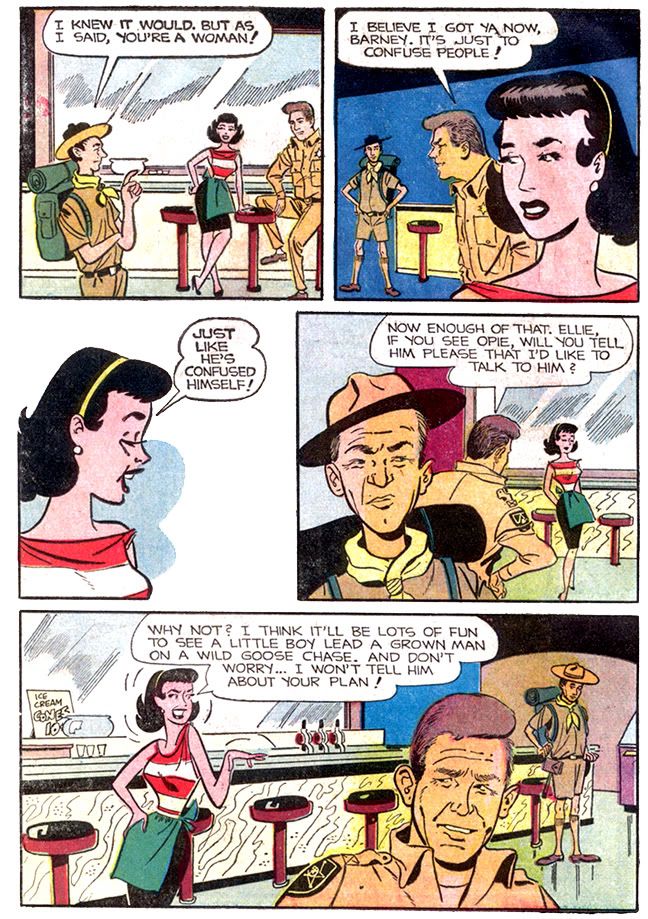 |
| This page has a "Love and Rockets" vibe. |
Ellie disappears from the comic after the first issue, and Opie barely appears in "Undercover Man," the story making up the second issue-- just long enough to mock Deputy Barney, who's on a crime-busting kick involving crazy disguises-- but what's really lacking in both is more of Mayberry's vividly realized citizenry. The most glaring omission is Floyd the barber. Floyd is a Mayberry essential. In the show's first two or three seasons, the barber is kind of an energetic loud mouth, a bit excitable and with a wife and teenaged son (although they seem to have been dropped down the same memory hole as Ellie about the time Floyd started courting a woman via romantic letters in "Floyd, the Gay Deceiver"). When veteran comedic actor Howard McNear suffered a debilitating stroke, the show temporarily dropped the character before bringing him back as the soft-spoken, addle-pated soul so uncannily parodied by Eugene Levy on SCTV.
It's just not Mayberry without a visit to Floyd's barber shop, but the comic's version is a mean-spirited lout named either Joe or Charlie. Barney never makes it clear which is which. He only refers to them using both names. Joe, or Charlie as he may be called, vaguely resembles McNear, but his physical humiliation of Barney is a step beyond something Floyd would do, not that first season Floyd was shy about dogpiling on the excitable deputy with the other Mayberrians. Or Mayberrites.
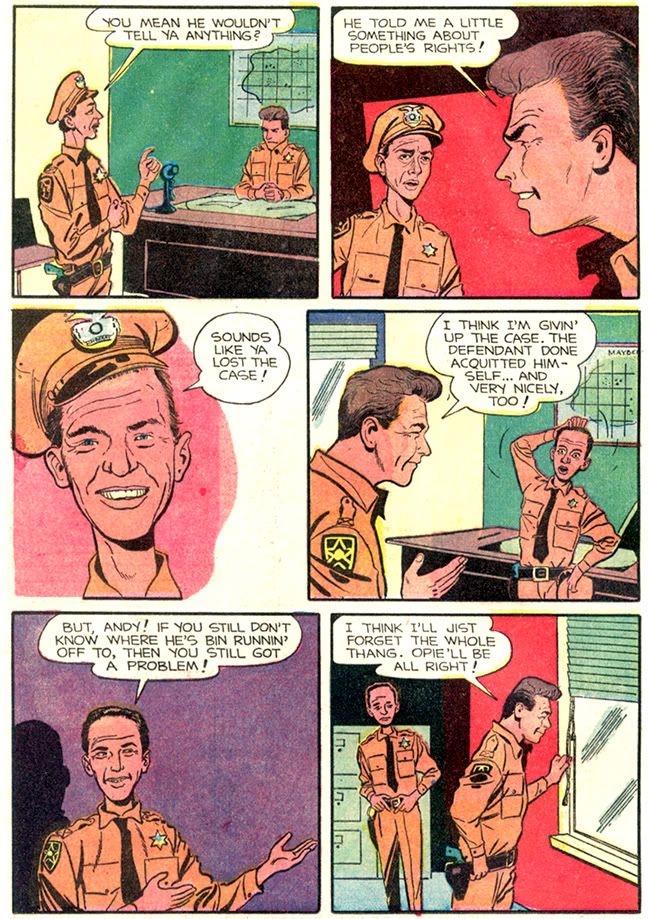 |
| Green, red, purple walls, orange uniforms! |
We get a token appearance from Aunt Bee, who helps Barney with his cross-gender disguise, but I can picture an entire spin-off series starring Ernest T. Bass, with the Darling family as his supporting cast or antagonists. You know, Bass as an anti-hero, kind of like Marvel's Tomb of Dracula minus the supernatural horror, murders and misogyny but with a heapin' helpin' of bluegrass music and Denver Pyle blowing into a jug. Speaking of, there's nary a hint of either Pyle, Gomer or Goober. And Helen Crump had not yet made her way onto the faculty of Mayberry's elementary school.
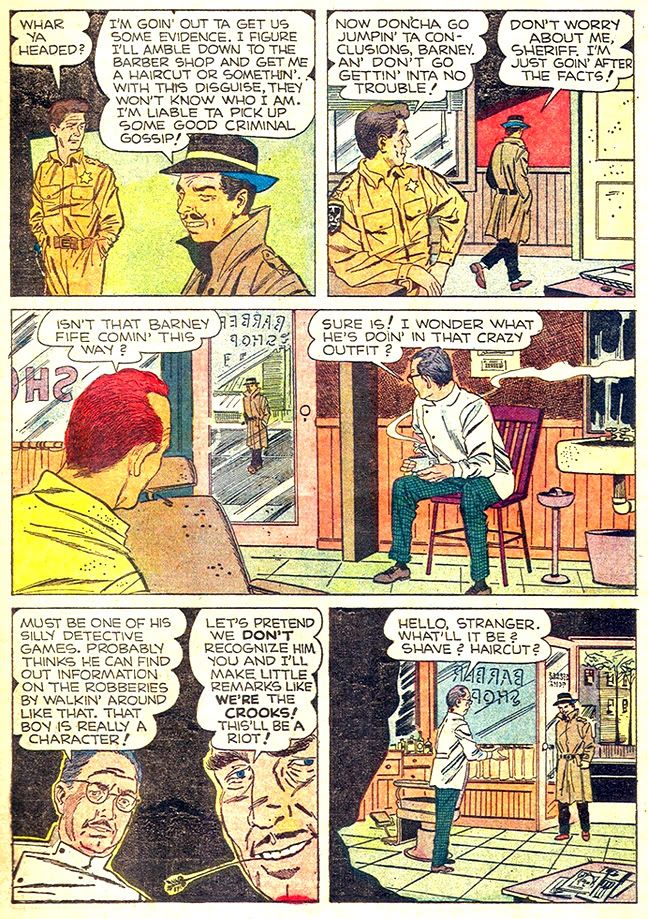 |
| Who are these jackasses? |
I have to say his acting is a strong point in "Opie's Secret." First rate, even. Scarpelli rarely repeats a facial expressions, and when the focus is on the faces, his drawings are absolutely fun and appealing. Some of the faces remind me of Daniel Clowes's work, where he seems to be illustrating a specific type of human being. There's no ironic distancing or sense of alienation in Scarpelli's drawings, just successfully adding interest to scenes that are mostly just two or three people standing around talking to each other. I really love Ellie's pissed off looks and Andy's obvious discomfort in "Opie's Secret."
For the Barney-centric "Undercover Man," which features a lot more crime-busting action than "Opie's Secret," (i.e., some) Scarpelli adopts a more naturalistic approach. Bodies are degrees more realistically proportioned and not nearly so exaggerated. Scarpelli attempts caricatures more than Alex Toth did with his No Time For Sergeants adaptation and the characters are easily recognizable, despite a few lapses. There's Barney's occasional weasel-like nose, but the lips are pure Don Knotts, even coated with bright red lipstick. While there's plenty of Griffith in him, Andy also frequently resembles character actor Hoke Howell, who played Dud Wash on the show before being supplanted in the part by Bob Denver, TV's Gilligan. It's still reasonably close.
 |
| Show accurate Mayberry! |
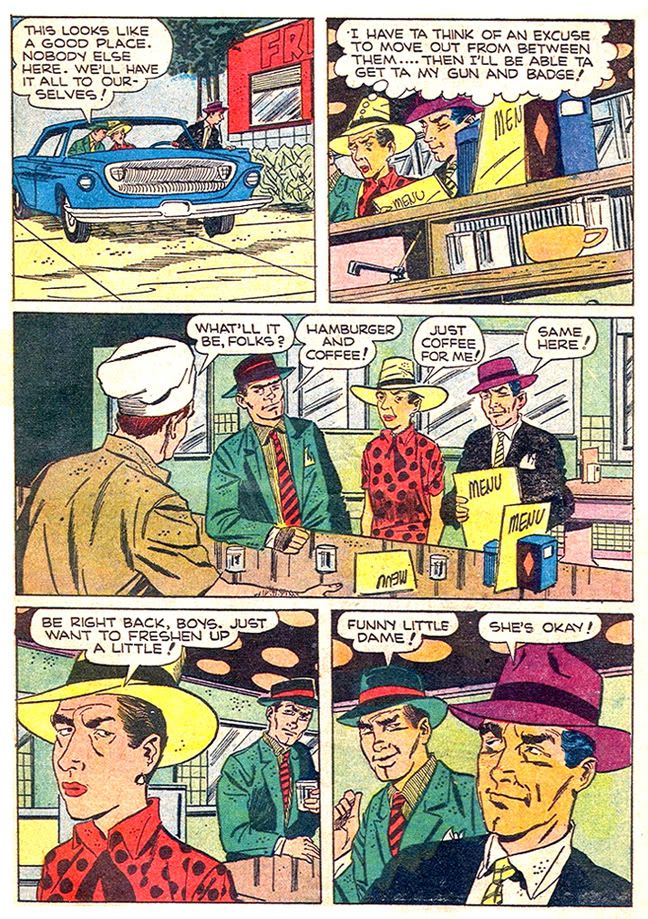 |
| Dick Tracy villains think Barney's cute. |
Of the two comics, the second is the most artistically successful and appealing. Scarpelli is a fine choice as artist, and his work is adequate, if not quite as inspired as his later Archie strip. I don't know who else you'd give this job to with my own first choice Jack Davis doing movie posters and covers to TV Guide, high paying, high prestige gigs and second choice Mort Drucker holding forth in Mad. The Andy Griffith Show isn't a property that would necessarily benefit from photorealism or some of the sub-Hal Foster flourishes you find in Dell's adaptation of the Kirk Douglas epic The Vikings, for example. Or even the kind of moody black-spotting someone like Alex Toth would have brought to it.
 |
| Nobody's perfect! |
These are just pleasant trifles, but I'm surprised at how they generally respect their source material. Nothing world-beating, though. These aren't lost early efforts from creators later recognized as genius-- like coming across an Our Gang comic written and drawn by Walt Kelly-- and the world hasn't suffered due to a lack of more The Andy Griffith Show comics from Dell. Scarpelli drew the Archie syndicated strip for fifteen years, and his art there is slick and easy on the eyes. Here, his work on the first issue hovers uncomfortably between realism and caricature, where masters like Jack Davis and Mort Drucker excelled. Scarpelli isn't up to their level, but that's like damning someone for being physicist without equalling Einstein. I'd be happy if anyone thought highly enough of my art to label me "not a genius."
No geniuses involved? Some expert will probably prove to me these were written by Jules Feiffer or a 9-year-old Alan Moore.
Given the choice-- and I often am-- I'd rather just watch an episode of the TV show. On the other hand, I wonder what Ron Howard thought about becoming a comic book character as a boy. No one called me "courageous" when I was ten. "Rotten little shit?" Oh man, all the time!

1 comment:
Where can I get the Andy Griffth comics?
Post a Comment